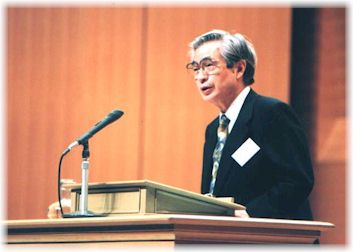|
"Starting with Ourselves The Destination of Education" |
|
Dr.Hideo Ohki,Seigakuin's Conference on Education |
Seigakuin University and Schools |
| Translated by Paul
T. Shew |
| I. Seigakuin's Conference on Education and the National Council on Educational Reform 1.
This year the government
established the National Council on Educational Reform. But Seigakuin's Conference on
Education began taking today's educational problems in Japan seriously well before this
with executive administrative meetings three years ago. The government's National Council
on Educational Reform and the Seigakuin Conference on Education are unintentionally
tackling educational problems from overlapping, competitive perspectives: from that of the
government and of the citizen. Of course, actively approaching it from either side is
good, and arguing over who started first is unnecessary. But it is not just simply about
the difference between the government and citizens, rather, it is becoming clear that the
philosophy is different, as are the goals to which we are aiming. The difference between
these meetings is that one was born of the political ambitions of Prime Minister Mori,
while the other represents the educational efforts of a whole school. 3.
During the five years
that Nakasone was in power from 1982 to 1987, he served as the political anchor man for
the fifty-five year establishment of the LDP's program for Japan's post-war economic
recovery. Previously, YOSHIDA Shigeru was criticized for not appreciating democracy when
he called himself 'Shin Shigeru', a word play
on his name, adding a feudal title for 'retainer', but Mr. Nakasone was an old style
politician to the bone, openly professing himself to be 'Otodo,' an aristocratic title, related to the word
for minister (daijin), literally meaning 'great
retainer'. During his government, Japan's
post-war economic reestablishment reached its peak and 'Japanism' flourished. Yoshida
imitated the British-style gentleman with a cigar in his mouth, but Nakasone was a
different type with a tendency, as it were, to act like the zealous commander in chief of
the Kanto Bushi (warriors). In his book, Nakasone claims himself to be an "arrogant
spirit" (transliterating the title from the English). This type of attitude was
formerly seen among the high-ranking military officers. Unfortunately, in English, the
word 'arrogant' does not have a positive meaning at all. It carries the negative meaning
of a haughty and insolent person who does not repent of their sins. I hesitate to mention
these arrogant politicians, but it is unavoidable to clarify the character and mission of
Seigakuin's Conference on Education held today. 4.
Nakasone's
root problem can be seen in his understanding of what happened in 1945. The underlining
definitive understanding in this book is that both the Japanese Constitution and the
Fundamental Education Law (FEL) are "the product of a policy to dismantle Japan"
(Japan's National Strategy for the Twenty-First
Century, p.197). I would like to point out the characteristics of Nakasone as a
politician, comparing him with two other foreign politicians at that time. One is a
comparison with the former chancellor of Germany, von Weizsäcker. Weizsäcker was
a politician who repented of war responsibility and had a vision for the future of Germany
starting from that repentance. Because of this, Germany gained international trust. The
other politician is President KIM Dae Jung of South Korea who recently received the Nobel
Peace Prize. Kim possessed universal values such as democracy and human rights and led to
the new formation of South Korea. Based on his philosophy, he also understood and avoided
the trap of over-emphasizing "Asian values." Nakasone lacks what both of these
men posses. This is amazingly clear in his book. What Nakasone possesses is a strange
perspective, viewing democracy and human rights in the Japanese constitution and in the
FEL as the "dismantling of Japan" and the cause of Japan's problems today. |
|
